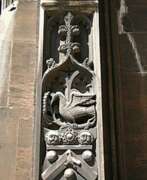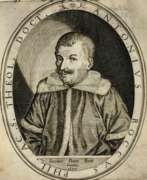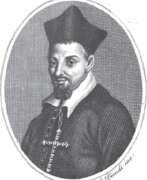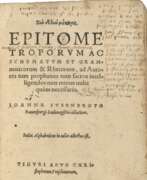Educators 16th century


Estienne de la Roche, also known as Estienne de Villefranche, was a French mathematician.
He is known for having taught mathematics in Lyon for 25 years as a professor of mathematics. In 1520 he published the Arismatics, considered at the time the best reference book on algebra.


Johann Dryander, born Johann Eichmann, was a German medical anatomist, mathematician and astrologer.
He studied anatomy and medicine at the University of Paris and the University of Erfurt, and in 1535 became professor of medicine at the University of Marburg. A year later, Dryander performed two public autopsies, making the first illustrated description of the dissection of the human brain. Dryander titled his book Anatomiae, hoc est, corporis humani dissectionis pars prior ("Anatomy, that is, the dissection of the human body, part one," suggesting a sequel, which, however, did not follow.
His work made a significant contribution to the development of modern anatomy. Toward the end of his life, Dryander also dabbled in astrology and mathematics.


Gabriele Falloppio was an Italian physician and anatomist of the Renaissance.
Originally a priest, Falloppio soon left for Ferrara to study medicine and was later appointed anatomy professor there, and in 1548 he became head of the anatomy department at Pisa. Three years later he accepted the offer of the Venetian Senate to become professor of anatomy, surgery, and botany at Padua, where he remained for the rest of his life. It was in this city that he made his most famous discoveries, was director of the famous botanical garden, and wrote two medical textbooks.
He also gained a reputation as an excellent teacher and lecturer, attracting many Italian and foreign students to the medical faculty of the University of Padua. As a physician, he made a thorough study of the clinical aspects and treatment of syphilis, and proposed the condom as a defense against venereal disease.
Falloppio was a versatile scientist and an able physician and surgeon, describing, among other things, the semicircular canals, the cuneiform sinuses, the trigeminal, auditory and lingual pharyngeal nerves, the canal of the facial nerve, and the fallopian tubes, named Fallopian tubes in his honor. Falloppio described his discoveries in his three-volume work Opera genuina omnia, published in Frankfurt in 1600 and in Venice in 1606.


Johannes Kepler was a German mathematician and astronomer who discovered that the Earth and planets move around the Sun in elliptical orbits.
Kepler created the three fundamental laws of planetary motion. He also did seminal work in optics and geometry, calculated the most accurate astronomical tables, and made many inventions and discoveries in physics on which further scientific discoveries by advanced scientists were based.


Fortunio Liceti (Latin: Fortunius Licetus) was an Italian physician, natural philosopher, writer and educator.
Liceti studied philosophy and medicine at the University of Bologna and earned doctorates in these disciplines. He taught logic and philosophy at the University of Pisa, and became professor of philosophy at the University of Padua and the University of Bologna. At the University of Padua, Liceti became friends with Galileo Galilei.
Liceti's inquisitive mind was interested in a wide range of subjects: from genetics and reproduction to gems and animals. In general, Fortunio Liceti was a very industrious and prolific scientist: he published a book each year, writing more than seventy works on a wide range of subjects, including the human soul, reproduction, and birth defects.
In 1616, Liceti wrote and published the first edition of De monstruorum causis, natura et differentiis (On the Causes, Nature, and Differences of Monsters), a chronologically ordered catalog of monsters from antiquity to the seventeenth century. Among these monsters were infants with congenital malformations. Liceti was one of the first scholars to attempt to systematically categorize birth defects according to their causes, including numerous causes not related to the supernatural. This topic interested the scientist greatly and he returned to it several times during his life, supplementing it with illustrations, among other things. From 1640 to 1650. Liceti also wrote and published seven different volumes in which he answered questions from famous people on a wide variety of medical topics.


Sebastian Münster was a German Renaissance scholar, cartographer and cosmographer, historian and linguist-translator.
Münster studied at the University of Tübingen and later taught at the Universities of Basel and Heidelberg. He published several editions of Hebrew grammars and translations from that language, and was the first German to produce an edition of the Hebrew Bible.
In 1544 Münster published his Cosmographia, which was the earliest description of the history, geography, and organization of the world in German. This book was a great success, translated into many European languages and reprinted more than twenty times. "Cosmographia" contained many illustrations and geographical maps of the continents of the world, created by the best engravers of the time.
Among his other works were the "Trilingual Dictionary" (1530) in Latin, Greek, and Hebrew and the "Map of Europe" (1536).


Francisco Pacheco del Río, baptized on November 3, 1564, and passing away on November 27, 1644, was a distinguished Spanish painter. Renowned for his dual role as Diego Velázquez's teacher and father-in-law, Pacheco's influence extends beyond his familial ties, contributing significantly to the arts through his seminal textbook, "Art of Painting." This work remains a crucial resource for understanding 17th-century artistic practices in Spain. Often referred to as the "Vasari of Seville," Pacheco's insights into painting theories and reflections on his contemporaries have left an indelible mark on the history of art, despite criticisms of his conventional execution in painting.
Pacheco's early life was marked by an immersive education in art, learning from Luis Fernandez and drawing inspiration from Italian masters. His journey included a pivotal sojourn to Madrid and Toledo in 1611 to study the works of El Greco, which further enriched his artistic repertoire. Upon his return to Seville, Pacheco opened an art school, laying the groundwork for his future contributions to art education and theory.
His career was notably characterized by his position as the official censor for Seville's Inquisition, which influenced his academic approach to religious subjects. Despite this, his paintings, such as the Last Judgment and Martyrs of Granada, are celebrated for their monumental scale. Pacheco's most enduring legacy, however, may be his influence on Diego Velázquez, whom he mentored for six years. Velázquez's marriage to Pacheco's daughter Juana in 1618 further solidified their personal and professional bonds. Pacheco's "Arte de la pintura" not only provided invaluable biographical information on Spanish painters of his era but also laid down foundational theories on iconography, materials, and technique.
For those interested in exploring Francisco Pacheco del Río's works further, notable pieces can be found in prestigious collections, such as the Museo Nacional del Prado, enriching our understanding of his impact on the art world.
Art enthusiasts, collectors, and experts are encouraged to sign up for updates to stay informed about new product sales and auction events related to Francisco Pacheco del Río, ensuring you remain at the forefront of developments in the fascinating world of art and antiques.
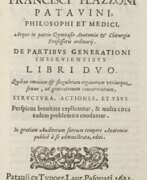

Francesco Plazzoni was an Italian physician and anatomist.
Plazzoni was a fellow student of Fabrizi and colleague of Spigellius, and taught in Padua. He is the author of the treatise De partibus generationi inservientibus libri duo (Padua, 1621). His text is based on Plazzoni's anatomical lectures in Padua and deals with the physiology of the penis, the clitoris, and sexual arousal.


Paolo Ricci (Italian: Paolo Ricci, Latin: Paulus Ricius, German: Paul Ritz), also known as Ritz, Riccio, or Paulus Israelita, was a humanist convert from Judaism, a writer-theologian, Kabbalist, and physician.
After his baptism in 1505 he published his first work, Sol Federis, in which he affirmed his new faith and sought through Kabbalah to refute modern Judaism. In 1506 he moved to Pavia, Italy, where he became a lecturer in philosophy and medicine at the university and met Erasmus of Rotterdam. Ricci was also a learned astrologer, a professor of Hebrew, philosophy, theology, and Kabbalah, a profound connoisseur and translator of sacred texts into Latin and Hebrew, and the author of philosophical and theological works.
Paolo Ricci was a very prolific writer. His Latin translations, especially the translation of the Kabalistic work Shaare Orach, formed the basis of the Christian Kabbalah of the early 16th century.


Celio Rodigino (Latin: Caelius Rhodiginus), real name Ludovico Ricchieri, was an Italian writer, educator and Renaissance humanist.
Rodigino studied in Ferrara and Padua, and then was professor of Greek and Latin at Rovigo. In 1515 he became chair of Greek at the University of Milan.
His principal work was Antiquarum Lectionum in sixteen books, published in Venice in 1516. In this work Rodigino collected a considerable number of short essays and notes on Latin and Greek antiquity, from literature, philology, and science to philosophy, history, anthropology, and morality, as well as reflections on ancient music. He also wrote commentaries on Virgil, Ovid, and Horace.


Desiderius Erasmus, also Erasmus of Rotterdam, or simply Erasmus (Latin: Desiderius Erasmus Roterodamus, Dutch: Gerrit Gerritszoon) was a Dutch humanist, philosopher, and the greatest scholar of the Northern Renaissance.
He was illegitimate and brought up under the name Gerhard Gerhards, later in Latin his name was dubbed Desiderius Erasmus. At the age of 13, the boy was sent to a monastery, where he later took the ministry. Erasmus read a lot, improving in Latin and Ancient Greek, studied oratory. A few years later he received the post of secretary to the bishop of the French city of Cambre. From 1493 to 1499 Rotterdam lived in Paris, then in London he was introduced to Thomas More, John Fisher, and John Colet.
Erasmus was constantly on the move, rarely staying in one place and traveling frequently between the Netherlands, Britain, France and Italy. In Turin he earned a doctorate in theology and was received by the Pope, then taught ancient Greek and theology at Cambridge. He corresponded with the rulers of various countries, popes and cardinals, and with statesmen, answering their questions of a scientific, political, and philosophical nature. As a true humanist, Erasmus of Rotterdam adhered to the ideas of a scientific spirit that favored research and true knowledge.
Among the merits of Rotterdamsky study of religious texts from a scientific position, critical interpretation of theology. Erasmus was able to lay the groundwork for historical-critical study of the past, especially in his studies of the Greek New Testament and the church fathers. His educational writings helped to replace the old school curriculum with a new humanistic emphasis on the classics.
In 1501, Erasmus produced a religious and ethical treatise, The Arms of the Christian Warrior, published in 1504. His work entitled "The Praise of Folly" was reprinted 40 times only during the author's lifetime, the book has been translated into all popular languages of the world. The series "Conversations in a Simple Way" (1518-1533) is among the most popular books on pedagogy. Erasmus promoted respect and care for children, opposing violence and corporal influence. He also promoted the idea that education should be compulsory for everyone.


John Skelton was an English poet and writer of the Tudor period.
He was educated at the University of Cambridge, followed by degrees in rhetoric at Oxford, in the Netherlands, and at Cambridge. He was also a translator of ancient Greek and Roman authors. In 1488 Skelton was appointed court poet to Henry VII and then tutor to the Duke of York (later Henry VIII). In 1498 he took holy orders.
Skelton was known as a poet and satirist on both political and religious subjects. His best-known works include the moralizing play Magnyficence (1516), the humorous poem The Tunning of Elinor Rumming (1520), and numerous satirical poems in which he ridiculed both secular and ecclesiastical authorities. His reputation was confirmed by Erasmus of Rotterdam himself, who spoke highly flatteringly of Skelton.


Israël Spach (also Israelis Spachius) was a German and French physician, medical writer and teacher of medicine.
Spach studied at the University of Tübingen, receiving the degree of doctor of medicine, and from 1589 taught medicine and Hebrew at the University of Strasbourg, with the rank of professor of medicine. He was characterized by a high bibliographical education.
Spach was the author of a gynecological encyclopedia, Gynaeciorum sive de mulierum tum communibus, tum gravidarum, parientium, et puerperarum affectibus et morbis, published in Strasbourg in 1597. It was a very significant book for its time.
Israël Spach also wrote Nomenclator scriptorum medicorum..., published in Frankfurt in 1591, which was the first attempt at a bibliography on medical subjects. It was organized under very broad subject headings, with indexes of authors and subjects.


Immanuel Tremellius or Giovanni Emmanuele Tremellio was an Italian reformer, Hebraist, translator, and professor of Hebrew.
Born in Ferrara to a Jewish family, Tremellius was educated in Padua and converted to Catholicism in 1540, but converted to Protestantism a year later and had to move from place to place. He taught Hebrew at Srasburg, at Cambridge, and later became professor of Old Testament at Heidelberg, Germany (1561). He eventually found refuge at Sedan College, where he died.
Immanuel Tremellius' main literary work was a Latin translation of the Bible from Hebrew and Syriac. He also translated Calvin's Catechism into Hebrew and Greek (1551) and published Bucer's Commentary on Ephesians, based on lectures he had heard at Cambridge (1562), as well as an Aramaic and Syriac Grammar (1569).


Andreas Vesalius (Dutch: Andries van Wesel) was a Flemish physician, one of the first anatomists of the Renaissance.
Vesalius came from a family of physicians and apothecaries, studied at the Catholic University of Leuven and at the medical school of the University of Paris, where he learned to dissect animals. He also had the opportunity to dissect human cadavers and devoted much time to the study of human bones. He later went to the University of Padua and, after earning his MD degree, was appointed professor of surgery, whose duties included anatomical demonstrations.
Vesalius revolutionized the study of biology and medical practice through his careful description of the anatomy of the human body. Based on observations made by himself, he wrote and illustrated the first complete textbook of anatomy. In 1543 his major work De humani corporis fabrica libri septem ("Seven Books on the Structure of the Human Body"), commonly known as Fabrica, was printed. In this epochal work, Vesalius gave far more extensive and accurate descriptions of the human body than anything that had been done by his predecessors.
In the same year, 1543, the Holy Roman Emperor Charles V appointed him staff physician of his house, and in 1559 Vesalius became physician to the Madrid court of Charles V's son, Philip II.
Vesalius' work made anatomy a scientific discipline with far-reaching implications not only for physiology but for all of biology.














